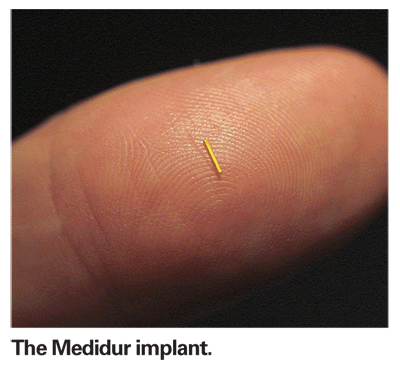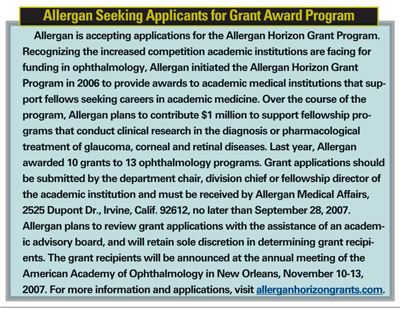Alimera Sciences and pSivida Limited announced that enrollment has begun for the first human pharmacokinetic study of fluocinolone acetonide in Medidur, the investigational product for the treatment of diabetic macular edema.
The Medidur insert is injected intravitreally and delivers a very low dose of fluocinolone acetonide to the retina for up to three years as a treatment for DME. Medidur FA is currently in a Phase III global clinical trial, the FAME (Fluocinolone Acetonide in Diabetic Macular Edema) Study that will follow approximately 900 patients in the 
The pharmacokinetic study is designed to support the FAME trial by providing pharmacokinetic/pharmacodynamic correlation data from DME patients. Sixteen patients are planned to be enrolled in this three-year, open-label study. Samples of blood and aqueous humor will be periodically taken to assess systemic and anterior chamber drug levels, respectively.
"Enrolling the same population in this study as in our FAME trial for DME will provide another important opportunity to learn more about the effect of FA on various aspects of this condition, as well as assess systemic drug levels," said Ken Green, PhD, chief scientific officer for Alimera. "This study will also provide information on the location of Medidur FA in the eye after insertion and drug levels in the anterior chamber."
Alimera Sciences and pSivida Limited have a worldwide agreement to co-develop and market the Medidur insert for the use of FA to treat DME. The agreement also includes the option to identify other compounds for ophthalmic diseases, potentially resulting in three additional products with the Medidur insert.
Information on the Medidur implant was inadvertently omitted from last month's article, "Novel Approaches to Diabetic Macular Edema."
Program Improves ROP Diagnosis
Researchers at Duke University School of Medicine say that a computer program successfully reduces subjectivity and enhances the evaluation of plus and pre-plus retinopathy of prematurity, based on a pilot study.
The program, ROPtool, automatically traces retinal blood vessels and measures their tortuosity and dilation. The study sought to determine its reliability and validity, and establish appropriate numerical thresholds for plus and pre-plus disease.
David K. Wallace, MD, and his co-investigators collected 20 high-quality images of the posterior poles of premature infants. Two of the authors independently judged tortuosity and dilation separately as plus, pre-plus or normal for each quadrant of each image. Disagreements were adjudicated, and the results were considered to be the standard for comparison to ROPtool. These two authors then separately used ROPtool to analyze the same 20 images.
For determination of tortuosity sufficient for plus disease, ROPtool interuser agreement was 95 percent (19/20), compared with 90 percent (18/20) agreement by investigator judgment. Eye-level (two MDs X 20 eyes) sensitivity of ROPtool in detecting tortuosity sufficient for plus disease averaged 95 percent (21/22) and specificity averaged 78 percent (14/18). Quadrant-level (two MDs X 20 eyes X four quadrants) sensitivity averaged 85 percent (66/78) and specificity averaged 77 percent (63/82). A numeric threshold for pre-plus disease equal to 70 percent of the average tortuosity of the standard photograph of plus disease resulted in mean sensitivity of 89 percent (103/116) and mean specificity of 82 percent (36/44) in distinguishing quadrant-level tortuosity sufficient for pre-plus disease or worse from normal. The study appears in the August 2007 Journal of American Association for Pediatric Ophthalmology and Strabismus.

A 'Wake-Up Call' For Baby Boomers
Nearly two-thirds of baby boomers—62 percent, or 46.9 million people—are not concerned that they will become visually impaired or have vision loss that cannot be corrected by glasses, surgery or medication. However, 12 percent of them (9.1 million) actually report having some vision trouble such as reading ordinary newspaper print even when wearing glasses or contact lenses, according to a survey by Harris Interactive conducted on behalf of Lighthouse International. Further, 14 percent (10.6 million) say they have some difficultly with basic living skills such as cleaning, cooking, bathing, shaving or getting to places outside the home (or are unable to do them without assistance) because of problems with their vision.
"This is a wake-up call for baby boomers to take their eye health more seriously," said Tara A. Cortes, PhD, RN, president and CEO of Lighthouse International. "The findings are especially surprising since baby boomers are a generation known for being proactive about their health. We are on the verge of a national vision-loss epidemic, and the baby boomers are very much in the spotlight. They are at risk for such diseases as age-related macular degeneration, diabetic retinopathy and glaucoma."
The national phone survey, conducted in August 2007, also found that a majority of respondents do not get an annual eye exam:
• Less than half (46 percent) of Americans say they get an annual eye exam.
• Among this group, 49 percent of whites say they get an annual eye exam, as compared with 37.5 percent of blacks and Hispanics.
• Only three in 10 Americans say they wear sun glasses for eye health. Twenty-six percent of African Americans and Hispanics say they wear sun glasses for eye health.
• Only a small percentage of respondents said that they take other important steps for their eye health such as stopping smoking (1 percent), eating green leafy vegetables (7 percent) and exercising (2 percent). Smokers double their risk of developing AMD compared to non-smokers.
• Despite saying they are not concerned about vision impairment, 82 percent of baby boomers "would seek services from a vision service agency for themselves or a loved one" if they had vision loss that could not be corrected with glasses, surgery or medication. Among the main reasons they cited are: independence and taking care of themselves (22 percent) and because vision services agencies are specialists (13 percent).
"It is good to know baby boomers would seek our services," adds Dr. Cortes. "Unless they become more proactive about eye health they may indeed need vision rehabilitation services in the future." Such services include low-vision eye exams by an ophthalmologist, optometrist and other low-vision specialists; mobility training; mental health counseling; career services; and training in using computers and new technology and devices to enable the person to read, work, function and live productively.
The telephone study included more than 1,000 adults ages 18 and over, of whom 384 were baby boomers (i.e., those ages 43 to 61). Results were weighted for age, race, region and gender where necessary to align them with their actual proportions in the population.
Study: Statins Don't Impact DR Development
Despite recent studies suggesting that statins may help prevent the progression of diabetic retinopathy, an
The mechanism by which statins may affect the progression of DR remains unclear. Until now, the potential for statins to prevent the development of DR among diabetic patients had not been assessed in an epidemiologic study. Researchers at the
Researchers Identify Exfoliative Glaucoma Gene
Researchers in
Two versions of the gene were associated with an increased risk of exfoliative glaucoma. One variant produced a 26-fold increased risk, the other an eightfold increase, compared to low-risk versions of the gene.
The next step is to develop a genetic test, which deCODE hopes to accomplish shortly. The findings are published in the August 9 issue of the journal Science.



